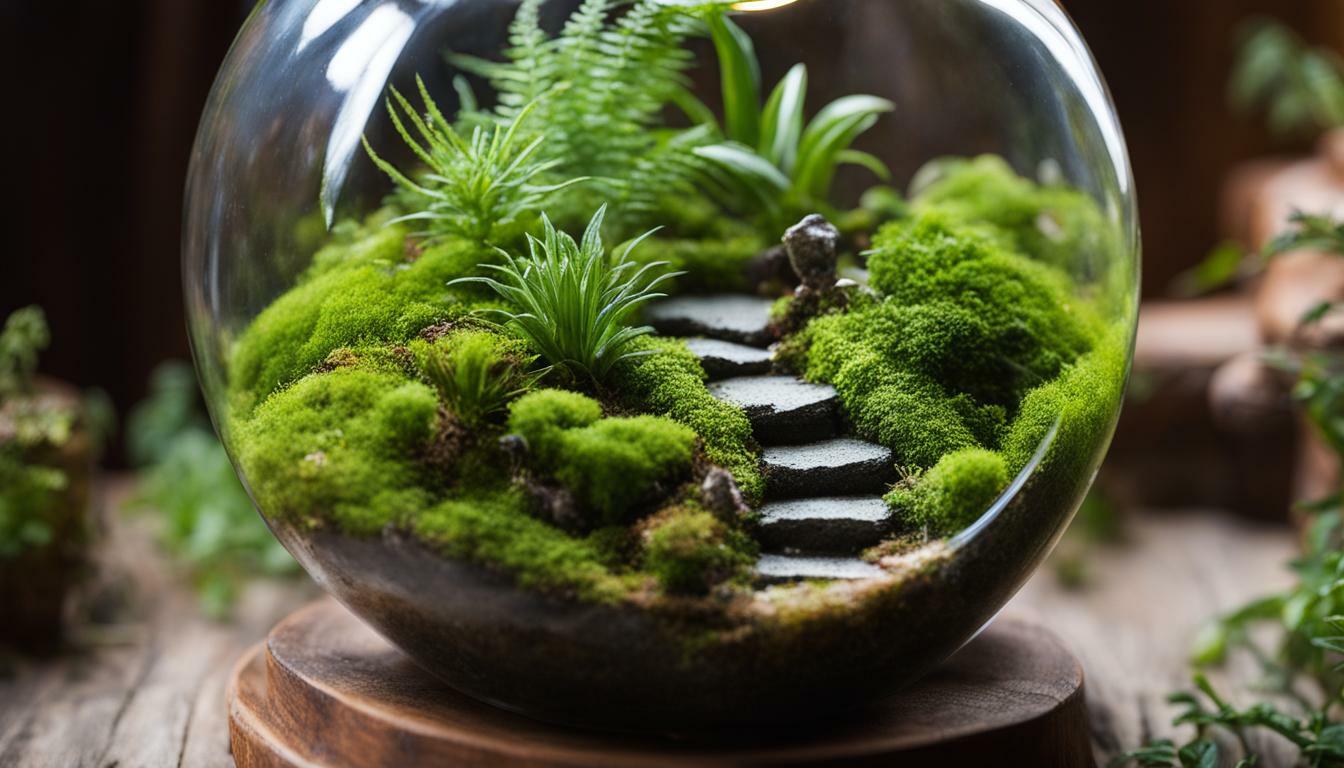Terrariums are captivating miniature ecosystems that offer a glimpse into the wonders of the natural world. They allow you to observe the beauty of nature up close while nurturing a self-sustaining environment in a confined space.
Key Takeaways:
- Terrariums are miniature ecosystems that bring the outdoors indoors.
- They provide a unique opportunity to observe nature up close and personal.
- Creating a self-sustaining environment within a confined space is the essence of terrarium keeping.
- By understanding the history and types of terrariums, you can choose the perfect one for your needs.
- Terrariums offer numerous benefits, including stress reduction and improved indoor air quality.
The History and Evolution of Terrariums
The history of terrariums dates back to the 19th century when Dr. Nathaniel Bagshaw Ward accidentally discovered the enclosed plant environment. While studying insects, he placed a moth chrysalis in a sealed glass jar and noticed that fern spores had germinated and grown inside the jar. This accidental observation led him to create the first successful terrarium, known as the Wardian case. Dr. Ward’s invention revolutionized plant transportation, allowing delicate species to survive long journeys by sea.
Dr. Ward’s invention gained popularity, and terrariums became a symbol of Victorian-era elegance and luxury. Wealthy individuals adorned their homes with elaborate terrariums, showcasing exotic plants from around the world. These miniature gardens provided an escape into nature, even in the confines of urban living.
Over time, terrariums evolved from scientific curiosities to beloved decorative pieces. They became accessible to a wider audience, with various styles and designs catering to different tastes. Today, terrariums continue to captivate enthusiasts, offering a unique way to bring nature indoors and create miniature ecosystems filled with beauty and wonder.
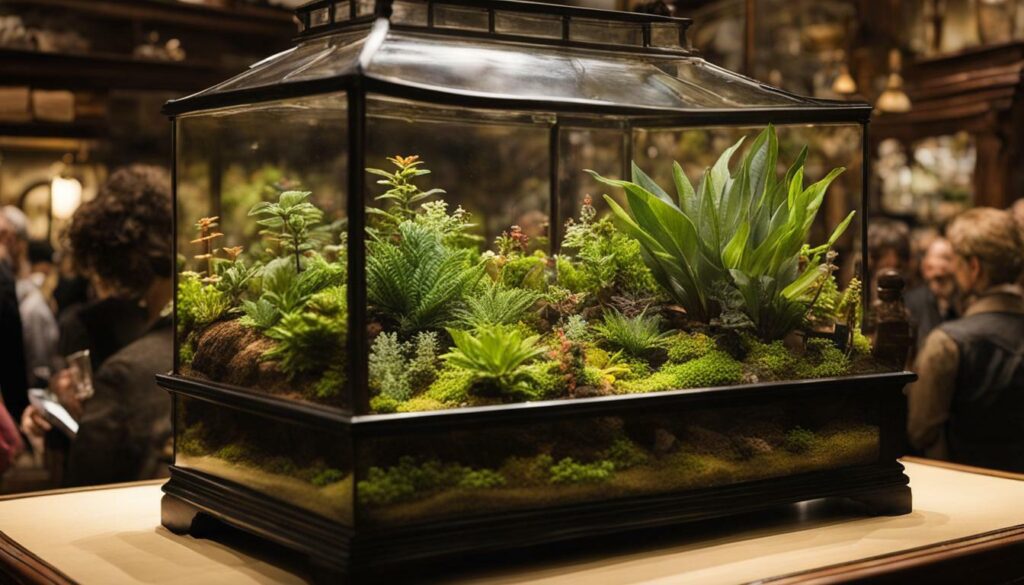
As the popularity of terrariums grew, so did the techniques and designs associated with them. Different types of containers, such as glass jars and fish tanks, were used to create terrariums of various sizes and shapes. Open terrariums became favored for low-maintenance plants, while closed terrariums provided a controlled environment for tropical species. Hanging terrariums emerged as a creative way to display greenery from above, adding an element of whimsy to any space.
| Type of Terrarium | Description |
|---|---|
| Open Terrarium | Unsealed container with lower humidity levels, suitable for plants that prefer drier conditions. |
| Closed Terrarium | Sealed container creating a self-sustaining environment, ideal for plants that thrive in higher humidity. |
| Hanging Terrarium | Suspended from the ceiling or a support structure, adding a touch of creativity and visual interest to any space. |
Terrariums offer more than just decoration. They have numerous benefits, including stress reduction, improved indoor air quality, and educational opportunities. The presence of plants indoors has been proven to reduce stress and increase overall well-being. Terrariums act as natural air purifiers, removing toxins from the environment and improving indoor air quality. Additionally, they provide opportunities for learning and education, especially for children, who can observe the growth and development of plants and gain a deeper understanding of the natural world.
In conclusion, the history and evolution of terrariums have transformed these miniature wonders into beloved decorative pieces. Dr. Nathaniel Bagshaw Ward’s accidental discovery paved the way for the popularity of terrariums, creating a bridge between nature and urban living. Today, terrariums continue to captivate enthusiasts with their beauty and unique charm, offering a glimpse into a world of miniature wonders.
Types of Terrariums: From Open to Hanging
There are several types of terrariums, including open terrariums, closed terrariums, hanging terrariums, and fairy gardens. Each type offers its own unique charm and appeal, allowing you to create a miniature world that suits your style and preference.
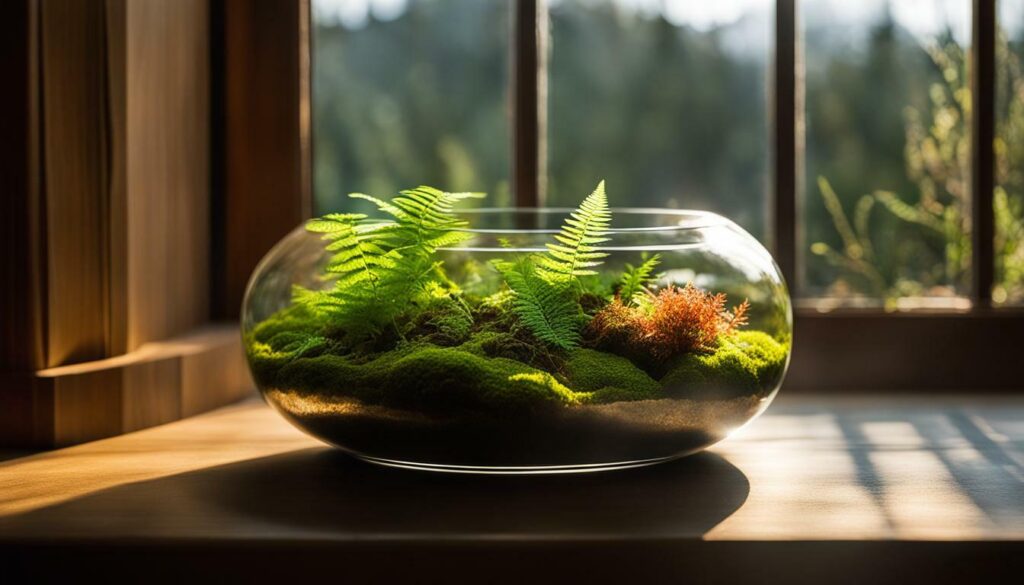
Open terrariums are perfect for those who enjoy a more hands-on approach to gardening. These terrariums feature unsealed containers, allowing air to circulate freely. They are suitable for plants that prefer lower humidity levels and don’t require a lot of moisture. With an open terrarium, you can create a beautiful and natural-looking scene, with plants arranged in a way that mimics their natural habitat.
Closed terrariums, on the other hand, feature sealed containers that create a self-sustaining environment. The sealed environment helps to trap moisture, creating a higher humidity level that is ideal for plants that thrive in tropical or humid conditions. Closed terrariums require less frequent watering and are a great option for those who prefer a low-maintenance approach to gardening.
Hanging terrariums add a touch of whimsy and can be a unique way to display your miniature wonders. These terrariums are suspended from the ceiling or a support structure, allowing you to create a captivating visual display. Hanging terrariums come in various shapes and sizes, and you can choose from a wide range of styles to suit your taste.
Fairy gardens are a magical variation of terrariums that incorporate small figurines and decorative elements to create a whimsical scene. They are often designed to resemble miniature landscapes, complete with tiny houses, bridges, and other enchanting features. Fairy gardens offer endless possibilities for creative expression and can transport you to a world of imagination.
Examples of Terrarium Types:
| Terrarium Type | Description |
|---|---|
| Open Terrarium | Unsealed containers, suitable for plants that prefer lower humidity levels. |
| Closed Terrarium | Sealed containers that create a self-sustaining environment, ideal for plants that prefer higher humidity levels. |
| Hanging Terrarium | Suspended from the ceiling or a support structure, adds a touch of whimsy to any space. |
| Fairy Garden | Incorporates small figurines and decorative elements, creates a magical and enchanting scene. |
With the wide range of terrarium types available, you can unleash your creativity and create a miniature wonderland that reflects your unique personality. Whether you prefer the simplicity of an open terrarium or the enchantment of a fairy garden, there’s a terrarium type for everyone. So, dive into the world of miniature wonders and let your imagination run wild!
The Benefits of Terrariums: More Than Just Decoration
Terrariums offer several benefits, making them more than just decorative pieces. They have gained popularity not only for their aesthetic appeal but also for their ability to enhance our well-being and living environments. Here are some of the key benefits of having terrariums in your home:
- Stress Reduction: Bringing nature indoors through terrariums can help reduce stress and promote relaxation. The sight of greenery and the calming effect of plants have been known to have a positive impact on our mental health.
- Indoor Air Quality Improvement: Terrariums act as natural air purifiers, filtering out toxins and releasing oxygen. They help improve indoor air quality by absorbing carbon dioxide and other harmful pollutants.
- Educational Opportunities: Terrariums provide a unique educational experience, especially for children. They offer a hands-on opportunity to learn about plant life, ecosystems, and the delicate balance of nature.
- Low Maintenance: Unlike traditional gardens, terrariums require minimal maintenance. They are self-contained ecosystems that recycle water, reducing the need for frequent watering. This makes them ideal for busy individuals or those with limited gardening experience.
By incorporating terrariums into your living space, you can create a tranquil environment that promotes well-being and enhances the aesthetics of your home. The lush greenery and natural elements add a touch of serenity to any room, providing a calming retreat from the stresses of everyday life.
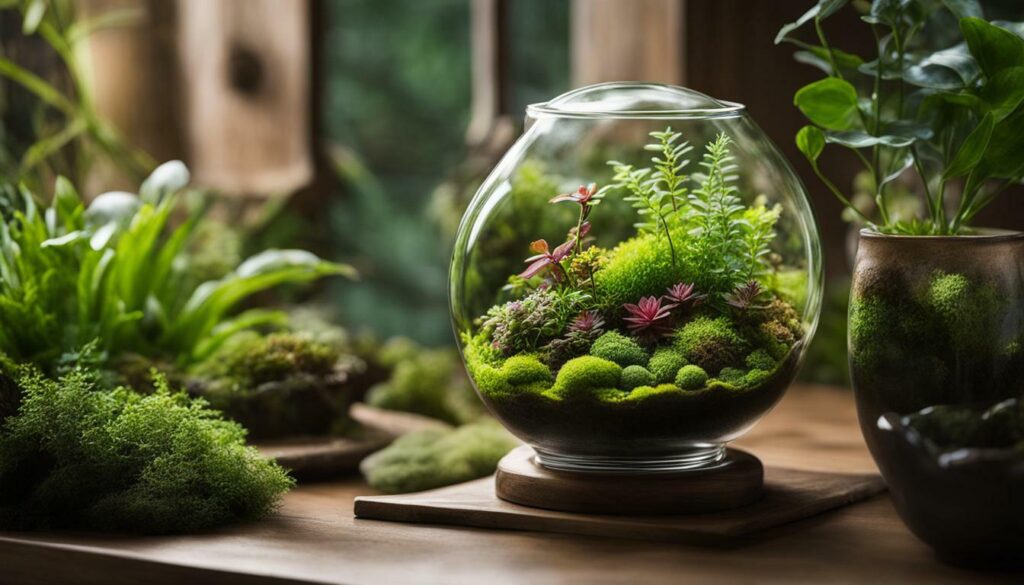
Choosing the Right Container for Your Terrarium
When creating a terrarium, it is important to choose the right container to provide a suitable environment for your plants. Two popular options are glass jars and fish tanks, both of which have their advantages and considerations.
Glass jars are a classic choice for terrariums, offering a clear and aesthetically pleasing view of the miniature world inside. They come in various shapes and sizes, allowing for creativity and customization. The transparency of glass jars also ensures that your terrarium receives ample light, which is essential for plant growth. Additionally, glass jars are generally more affordable and readily available.
On the other hand, fish tanks provide a larger space for creating elaborate terrariums. Their spaciousness allows for the inclusion of more plants and decorative elements, giving you the opportunity to design a diverse and vibrant ecosystem. Fish tanks also offer better ventilation, making them suitable for plants that require good air circulation. However, it is crucial to consider the size of the fish tank and ensure that it fits comfortably in your chosen location.
Ultimately, the choice between a glass jar and a fish tank comes down to personal preference, available space, and the desired terrarium design. Whichever container you select, it should provide enough room for your plants to grow and thrive while complementing the overall aesthetic of your terrarium.
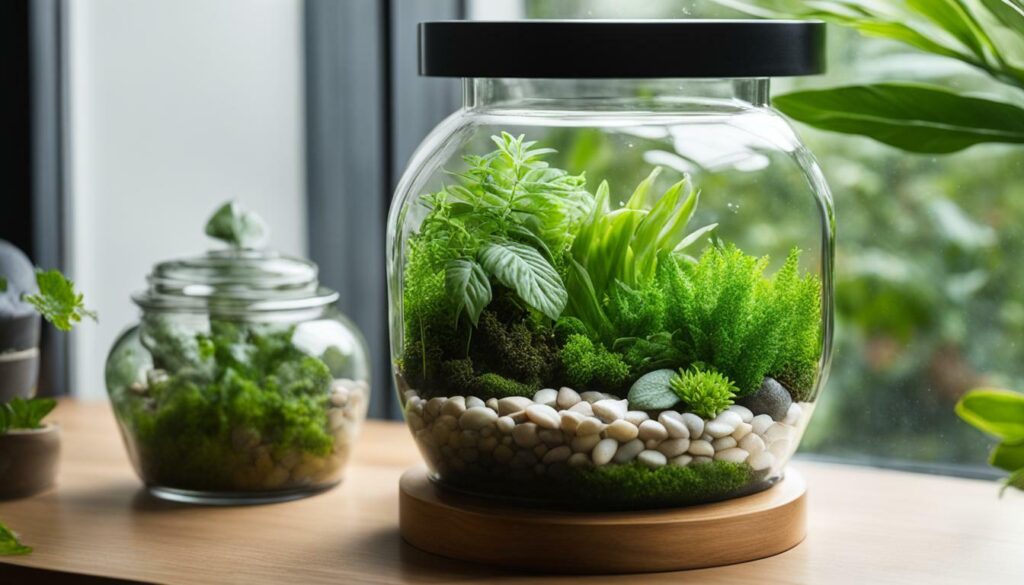
| Container | Pros | Cons |
|---|---|---|
| Glass Jar | • Clear view of terrarium • Affordable and readily available • Allows ample light | • Limited space for plants • Restricted air circulation • May require careful handling |
| Fish Tank | • Spacious for elaborate designs • Better ventilation • Suitable for larger plants | • Takes up more space • Potentially higher cost • Requires appropriate location |
Source: Own Compilation
Selecting Plants for Your Terrarium
Suitable plants for terrariums include mosses, ferns, succulents, cacti, and Fittonia. These plants thrive in the enclosed environment of a terrarium, requiring minimal care and attention. Each plant brings its unique charm and contributes to the overall aesthetics of the miniature world you create. Let’s explore some of the popular plant options for your terrarium:
- Mosses: Mosses are versatile and can adapt to a range of terrarium conditions. They add a lush and vibrant touch to your terrarium landscape.
- Ferns: Ferns are known for their delicate fronds, adding an elegant and airy feel to your terrarium. They prefer higher humidity levels and thrive in closed terrariums.
- Succulents: Succulents are perfect for open terrariums as they require less moisture. These water-storing plants come in various shapes, sizes, and colors, offering a visually diverse terrarium display.
- Cacti: Cacti are ideal for open terrariums due to their love for dry conditions. Their unique forms and spiky textures create an intriguing focal point in any terrarium.
- Fittonia: Fittonia, also known as nerve plants, are prized for their vibrant and variegated foliage. They thrive in high humidity environments, making them an excellent choice for closed terrariums.
Remember to consider the overall size, growth rate, and compatibility of the plants you choose for your terrarium. Combining different textures, heights, and colors can create a visually captivating and harmonious display. Experiment with different combinations to achieve the desired look and feel for your miniature world.
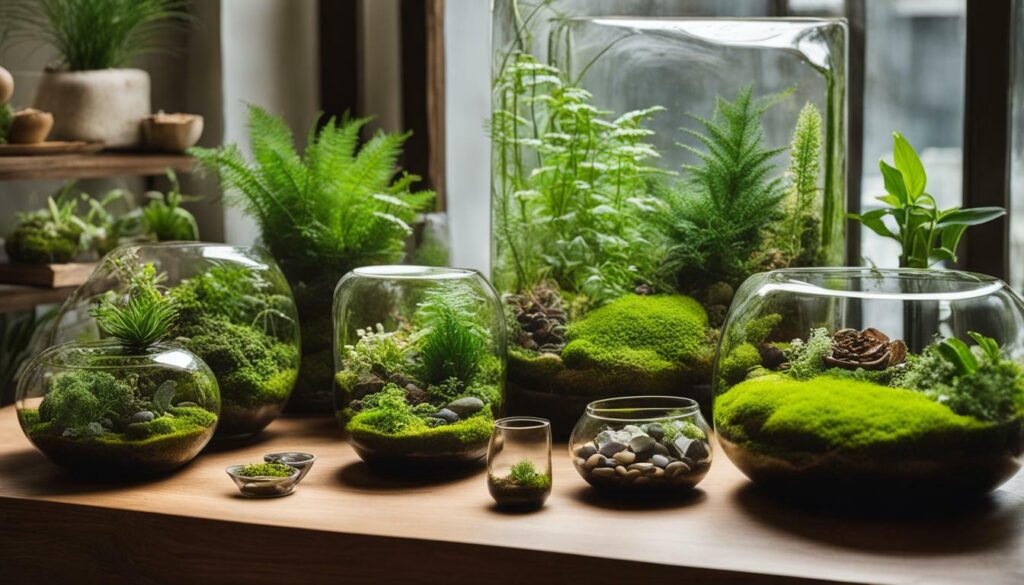
Step-by-Step Guide to Creating a Terrarium
To create a terrarium, start by adding a layer of small rocks or pebbles for drainage, followed by activated charcoal and potting mix. This layering ensures proper drainage and prevents waterlogged soil, which can be harmful to the plants. The rocks or pebbles create a reservoir at the bottom of the container, allowing excess water to accumulate without saturating the roots.
Next, sprinkle a thin layer of activated charcoal on top of the rocks. Activated charcoal helps absorb any odors that may develop in the terrarium and keeps the environment fresh. It also acts as a filter, removing impurities from the water and maintaining optimal conditions for the plants.
After the charcoal layer, add a generous amount of potting mix. This nutrient-rich soil provides a suitable growing medium for the plants. Gently pat down the soil to create a level surface for planting.
Now, it’s time to carefully plant your selected greenery. Start by creating small holes in the soil using your finger or a small spoon. Place the plants in the holes, making sure to position them securely, then cover the roots with soil. Be mindful of the plants’ sizes and growth habits, ensuring they have enough space to thrive within the confines of the terrarium.
Once the plants are in place, water the terrarium lightly. Avoid overwatering, as this can lead to root rot and other issues. It’s important to balance the moisture levels, allowing the soil to dry slightly between watering sessions. Observation and monitoring are key to maintaining appropriate moisture levels.
Adding decorative elements can enhance the visual appeal of your terrarium. Consider incorporating small figurines, colorful stones, or natural elements like driftwood or seashells. These accents can add a touch of personalization and create a unique miniature world within your terrarium.
Creating a terrarium is a delightful and rewarding project that allows you to connect with nature on a small scale. From layering the proper materials to choosing the perfect plants and adding decorative elements, each step contributes to the overall beauty and success of your terrarium. Maintain regular care and enjoy the lush green oasis you’ve created.
| Materials: | Instructions: |
|---|---|
| Small rocks or pebbles | Add a layer at the bottom of the container for drainage. |
| Activated charcoal | Sprinkle a thin layer on top of the rocks to absorb odors and impurities. |
| Potting mix | Add a generous amount to provide a nutritious soil base for the plants. |
| Selected plants | Carefully plant them in the soil, ensuring proper spacing and secure positioning. |
| Water | Lightly water the terrarium, maintaining balanced moisture levels. |
| Decorative elements | Add personal touches to enhance the visual appeal of your terrarium. |
Creating a terrarium is a creative process, allowing you to design your own miniature world using layering techniques, suitable plants, and decorative elements. With proper care and attention, your terrarium can thrive and bring you endless joy.
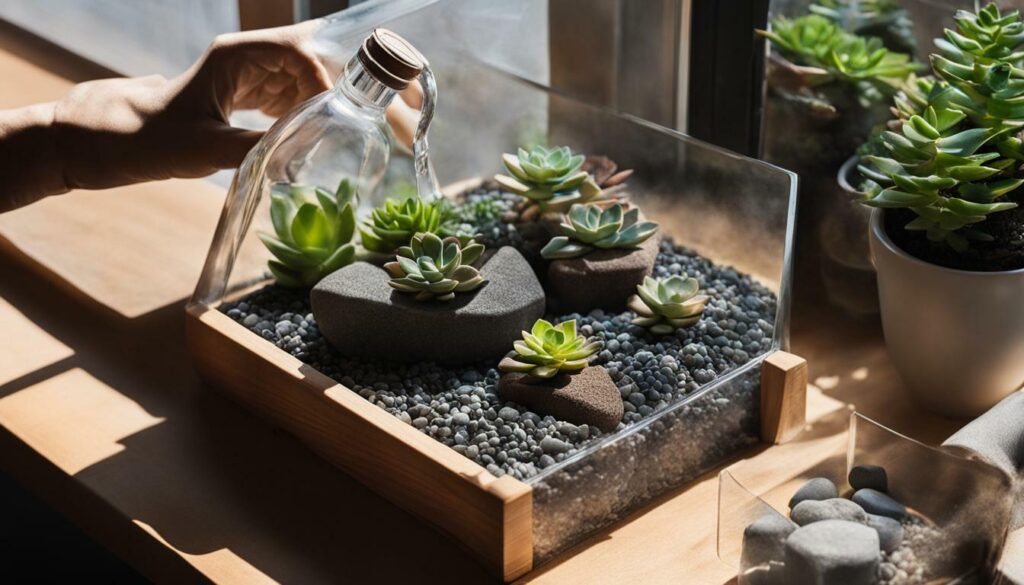
Terrariums offer a captivating and rewarding way to connect with nature and create a miniature green oasis in your living space. These enchanting glass enclosures bring the wonders of the natural world indoors, allowing you to immerse yourself in the beauty of lush greenery and delicate ecosystems. With their intricate designs and mesmerizing appeal, terrariums have become a popular choice for nature lovers and interior decorators alike.
Creating and caring for a terrarium provides a sense of joy and fulfillment as you witness the growth and transformation of your own miniature garden. The delicate balance of plants, soil, moisture, and light creates a self-contained ecosystem that can thrive with minimal effort. Whether you choose to craft a lush tropical rainforest or a serene desert landscape, the possibilities for terrarium designs are limited only by your imagination.
One of the most captivating aspects of terrarium keeping is its ability to transport you into a world of tranquility and serenity. By bringing nature indoors, terrariums offer a retreat from the stresses of everyday life. Studies have shown that surrounding yourself with greenery can help reduce stress levels, improve air quality, and boost your mood. The calming effect of watching plants grow and thrive in a controlled environment can provide a much-needed sense of peace and relaxation.
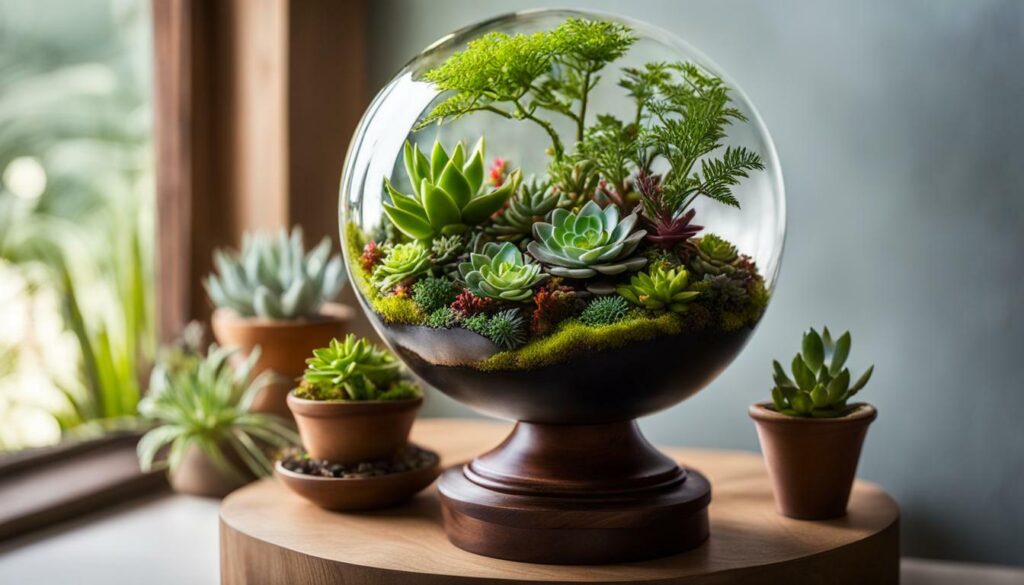
| Benefits of Terrariums | How They Enhance Your Space |
|---|---|
| Stress Reduction | Creating a soothing and calming environment that promotes relaxation |
| Air Quality Improvement | Acting as natural air purifiers by absorbing carbon dioxide and releasing fresh oxygen |
| Mood Boost | Elevating your spirits and promoting a positive outlook on life |
Whether you’re a seasoned gardener or new to plant care, terrariums offer an accessible and low-maintenance way to indulge your green thumb. With their self-contained nature, terrariums require minimal watering and upkeep. Once established, they can thrive for months without much intervention. This makes them an ideal choice for busy individuals or those who don’t have a green space of their own.
As you embark on your terrarium journey, remember that the true beauty and joy lie in the process of creation and nurturing. Each terrarium you craft is a unique expression of your creativity and love for nature. So, dive into this captivating world of miniature wonders and discover the endless possibilities that await you.
Endless Design Possibilities for Terrariums
Whether you prefer a lush tropical jungle or a minimalist desert landscape, the possibilities for terrarium design are endless. With a little creativity and the right combination of plants and decorative elements, you can create a stunning miniature world that reflects your personal style.
One popular design choice is to create a lush tropical terrarium. This type of terrarium often includes vibrant green mosses, ferns, and tropical plants that thrive in high humidity environments. Adding small figurines of animals or people can create a whimsical scene, while colorful stones or shells can add a touch of elegance.
On the other end of the spectrum, a minimalist desert landscape terrarium can create a striking visual statement. Using succulents and cacti, you can create a desert-inspired scene with sand or gravel as the base. Adding small stones and driftwood can enhance the natural aesthetic, while a few carefully placed decorative objects can add a unique touch.
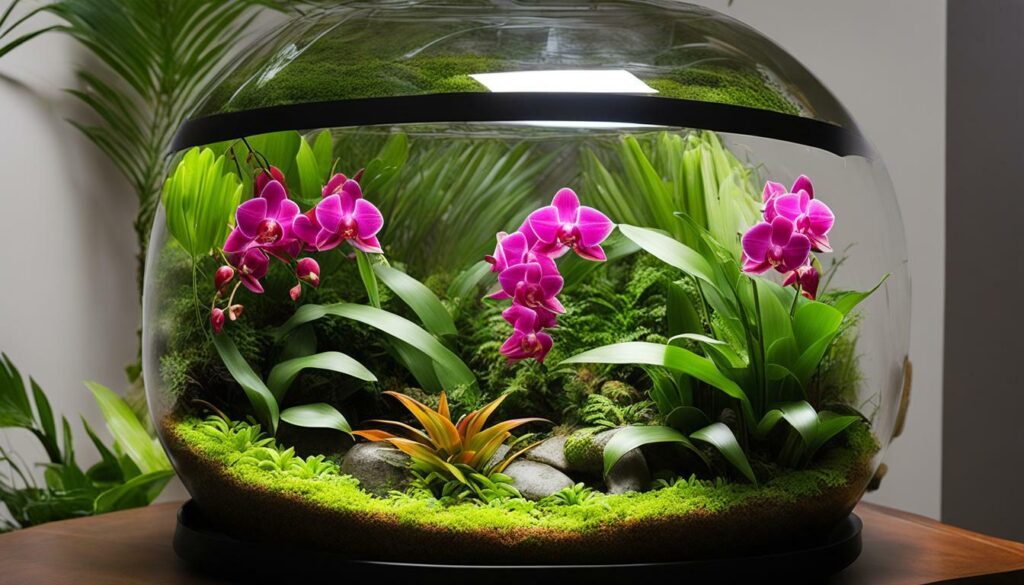
Don’t be afraid to experiment with different textures, colors, and plant varieties to achieve your desired look. You can create terrariums in different containers, such as glass jars, fish tanks, or even repurposed glassware. The key is to create a harmonious and visually appealing composition that brings joy to your space.
Remember, terrarium design is a form of self-expression, so let your creativity flow and have fun with it. The beauty of terrarium keeping lies in the endless possibilities and the satisfaction of creating a one-of-a-kind, miniature world of wonder.
Conclusion
In conclusion, unique terrariums offer a world of miniature wonders, providing an opportunity for nature lovers to create one-of-a-kind and unusual indoor ecosystems. These captivating creations bring the beauty of nature into our homes, allowing us to appreciate the intricate details of plant life on a small scale. With their lush greenery and delicate landscapes, terrariums bring a sense of tranquility and enchantment to any space.
Whether you opt for an open terrarium filled with ferns and mosses or a closed terrarium with succulents and cacti, the possibilities for creative terrarium designs are endless. You can create a lush tropical jungle, a serene woodland scene, or a minimalist desert landscape—all within the confines of a glass container. The only limit is your imagination.
Not only are terrariums visually stunning, but they also offer several practical benefits. They can act as natural stress relievers, bringing a sense of calm and relaxation to your surroundings. Additionally, terrariums help improve indoor air quality by absorbing carbon dioxide and releasing oxygen. They also require minimal maintenance, making them an excellent choice for those with busy lifestyles.
Embrace the Miniature Magic of Terrariums
The joy of terrarium keeping lies in the ability to create your own little world filled with miniature wonders. By carefully selecting plants, layering materials, and adding personal touches, you can design a unique terrarium that reflects your style and personality. It’s a chance to exercise your creativity and unleash your imagination.
So, why not embark on this captivating journey and bring the beauty of nature indoors? With unique terrariums, you can escape into a world of miniature wonders and discover the joy of nurturing your very own tiny ecosystem. Start small and watch as your terrarium grows into a breathtaking centerpiece that will leave both you and your guests in awe.
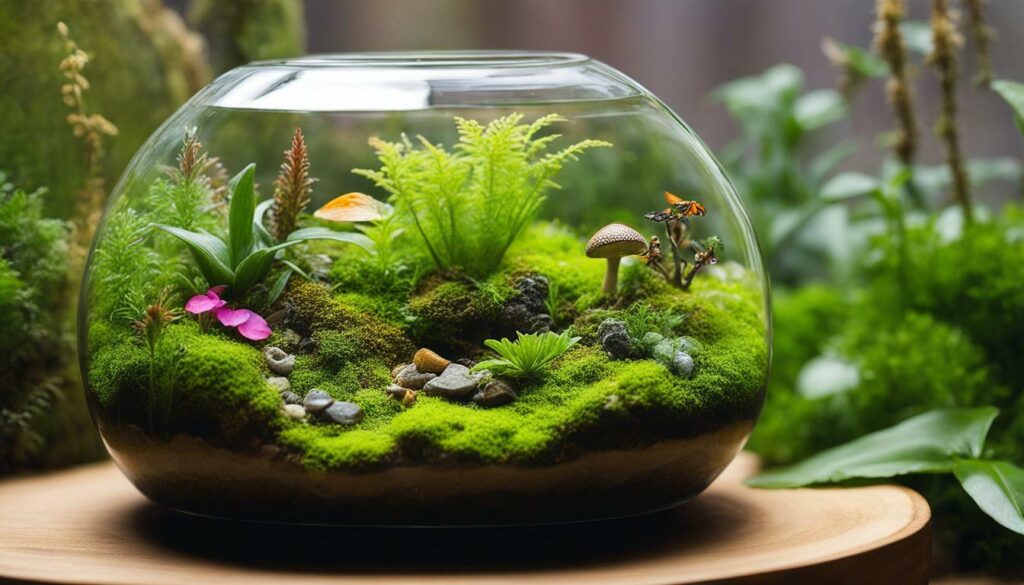
Happy terrarium keeping! Create your own miniature wonders and enjoy the beauty of unique terrariums. Terrariums offer a fascinating glimpse into the wonders of the natural world, allowing you to bring a piece of nature into your living space. Whether you choose an open terrarium that showcases plants thriving in low humidity or a closed terrarium that creates a self-sustaining environment, these miniature ecosystems are truly one-of-a-kind.
With a history dating back to the 19th century, terrariums have evolved from scientific curiosities to beloved decorative pieces. They offer a range of benefits beyond their aesthetic appeal. Terrariums act as natural air purifiers, improving indoor air quality by absorbing carbon dioxide and releasing oxygen. They also provide a calming effect, reducing stress and creating a soothing atmosphere in any room.
Creating a terrarium is a rewarding and creative experience. Choose the right container, such as a glass jar or fish tank, and select the appropriate plants that thrive in a terrarium environment. From mosses and ferns to succulents and cacti, there are endless possibilities for designing your own unique terrarium.
Nurturing and maintaining a terrarium requires minimal effort. Regularly monitor moisture levels, prune plants when necessary, and clean the glass container to keep your terrarium thriving. With the right care, your terrarium will continue to bring joy and beauty to your home for years to come.
So why wait? Embrace the world of miniature wonders and create your own unique terrarium today. Let the beauty and tranquility of these miniature ecosystems captivate your senses and uplift your spirit. Happy terrarium keeping!
Can the Same Principles for Creating Large Terrariums Apply to Miniature Terrariums?
When creating miniature terrariums, the same principles used for detailed large terrarium beauty discovery can still apply. Although on a smaller scale, the concept of layering soil, adding plants, and maintaining a balanced ecosystem remains consistent. Attention to detail is key for both large and miniature terrariums.
FAQ
What are terrariums?
Terrariums are miniature ecosystems that contain plants and create a self-sustaining environment within a confined space.
How did terrariums come to be?
Terrariums were discovered by Dr. Nathaniel Bagshaw Ward in the 19th century as he accidentally created an enclosed plant environment.
What are the different types of terrariums?
There are open terrariums, closed terrariums, hanging terrariums, and fairy gardens.
What are the benefits of having a terrarium?
Terrariums provide stress reduction, improve indoor air quality, offer educational opportunities, and require low maintenance.
How do I choose the right container for my terrarium?
You can select from a variety of containers, such as glass jars or fish tanks, based on the size and type of terrarium you want.
What types of plants are suitable for terrariums?
Mosses, ferns, succulents, cacti, and Fittonia are some of the plants that thrive in terrarium environments.
How do I create a terrarium?
Start by layering small rocks or pebbles for drainage, followed by activated charcoal and potting mix. Then, carefully plant the chosen greenery, water lightly, and consider adding decorative elements.
What maintenance is required for a terrarium?
Terrariums require monitoring moisture levels, pruning plants, cleaning the glass container, and providing the appropriate amount of light.
What are the aesthetic and emotional benefits of having a terrarium?
Terrariums offer visual beauty, reduce stress, improve air quality, and boost mood.
What are the design possibilities for terrariums?
From lush tropical jungles to minimalist desert landscapes, the design possibilities for terrariums are endless.

